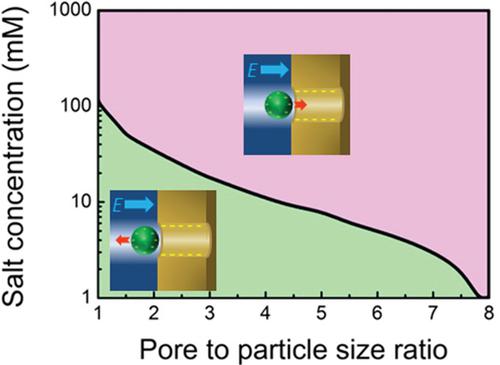当前位置:
X-MOL 学术
›
Electrophoresis
›
论文详情
Our official English website, www.x-mol.net, welcomes your
feedback! (Note: you will need to create a separate account there.)
Investigation of entrance effects on particle electrophoretic behavior near a nanopore for resistive pulse sensing
Electrophoresis ( IF 3.0 ) Pub Date : 2021-09-01 , DOI: 10.1002/elps.202100162 Chien Hsu, Chih-Yuan Lin, Amer Alizadeh, Hirofumi Daiguji, Wei-Lun Hsu
Electrophoresis ( IF 3.0 ) Pub Date : 2021-09-01 , DOI: 10.1002/elps.202100162 Chien Hsu, Chih-Yuan Lin, Amer Alizadeh, Hirofumi Daiguji, Wei-Lun Hsu

|
Resistive pulse sensing using solid-state nanopores provides a unique platform for detecting the structure and concentration of molecules of different types of analytes in an electrolyte solution. The capture of an entity into a nanopore is subject not only to the electrostatic force but also the effect of electroosmotic flow originating from the charged nanopore surface. In this study, we theoretically analyze spherical particle electrophoretic behavior near the entrance of a charged nanopore. By investigating the effects of pore size, particle–pore distance, and salt concentration on particle velocity, we summarize dominant mechanisms governing particle behavior for a range of conditions. In the literature, the Helmholtz–Smoluchowski equation is often adopted to evaluate particle translocation by considering the zeta potential difference between the particle and nanopore surfaces. We point out that, due to the difference of the electric field inside and outside the nanopore and the influence from the existence of the particle itself, the zeta potential of the particle, however, needs to be at least 30% higher than that of the nanopore to allow the particle to enter into the nanopore when its velocity is close to zero. Accordingly, we summarize the effective salt concentrations that enable successful particle capture and detection for different pore sizes, offering direct guidance for nanopore applications.
中文翻译:

电阻脉冲传感纳米孔附近粒子电泳行为的入口效应研究
使用固态纳米孔的电阻脉冲传感为检测电解质溶液中不同类型分析物分子的结构和浓度提供了一个独特的平台。将实体捕获到纳米孔中不仅受到静电力的影响,还受到源自带电纳米孔表面的电渗流的影响。在这项研究中,我们从理论上分析了带电纳米孔入口附近的球形粒子电泳行为。通过研究孔径、颗粒-孔距和盐浓度对颗粒速度的影响,我们总结了在一系列条件下控制颗粒行为的主要机制。在文献中,通过考虑颗粒和纳米孔表面之间的 zeta 电位差,通常采用 Helmholtz-Smoluchowski 方程来评估颗粒易位。我们指出,由于纳米孔内外电场的不同以及颗粒本身存在的影响,颗粒的 zeta 电位需要至少比纳米孔的 zeta 电位高 30%。纳米孔允许粒子在其速度接近零时进入纳米孔。因此,我们总结了能够成功捕获和检测不同孔径的粒子的有效盐浓度,为纳米孔应用提供直接指导。然而,由于纳米孔内外电场的不同以及颗粒本身存在的影响,颗粒的zeta电位需要至少比纳米孔的zeta电位高30%才能允许颗粒当其速度接近零时进入纳米孔。因此,我们总结了能够成功捕获和检测不同孔径的粒子的有效盐浓度,为纳米孔应用提供直接指导。然而,由于纳米孔内外电场的不同以及颗粒本身存在的影响,颗粒的zeta电位需要至少比纳米孔的zeta电位高30%才能允许颗粒当其速度接近零时进入纳米孔。因此,我们总结了能够成功捕获和检测不同孔径的粒子的有效盐浓度,为纳米孔应用提供直接指导。
更新日期:2021-09-01
中文翻译:

电阻脉冲传感纳米孔附近粒子电泳行为的入口效应研究
使用固态纳米孔的电阻脉冲传感为检测电解质溶液中不同类型分析物分子的结构和浓度提供了一个独特的平台。将实体捕获到纳米孔中不仅受到静电力的影响,还受到源自带电纳米孔表面的电渗流的影响。在这项研究中,我们从理论上分析了带电纳米孔入口附近的球形粒子电泳行为。通过研究孔径、颗粒-孔距和盐浓度对颗粒速度的影响,我们总结了在一系列条件下控制颗粒行为的主要机制。在文献中,通过考虑颗粒和纳米孔表面之间的 zeta 电位差,通常采用 Helmholtz-Smoluchowski 方程来评估颗粒易位。我们指出,由于纳米孔内外电场的不同以及颗粒本身存在的影响,颗粒的 zeta 电位需要至少比纳米孔的 zeta 电位高 30%。纳米孔允许粒子在其速度接近零时进入纳米孔。因此,我们总结了能够成功捕获和检测不同孔径的粒子的有效盐浓度,为纳米孔应用提供直接指导。然而,由于纳米孔内外电场的不同以及颗粒本身存在的影响,颗粒的zeta电位需要至少比纳米孔的zeta电位高30%才能允许颗粒当其速度接近零时进入纳米孔。因此,我们总结了能够成功捕获和检测不同孔径的粒子的有效盐浓度,为纳米孔应用提供直接指导。然而,由于纳米孔内外电场的不同以及颗粒本身存在的影响,颗粒的zeta电位需要至少比纳米孔的zeta电位高30%才能允许颗粒当其速度接近零时进入纳米孔。因此,我们总结了能够成功捕获和检测不同孔径的粒子的有效盐浓度,为纳米孔应用提供直接指导。











































 京公网安备 11010802027423号
京公网安备 11010802027423号